

It's not really fair to rant about the popular misuse of TV booster amplifiers without backing the rant up with facts. Without that the rant is just another load of uninformed opinion of which there's far too much on the Net already. So here's the lowdown. It's a bit technical, and all you really need to know is
Never, ever, directly cascade UHF amplifiers/boosters
Boosters always come before a loss, not after
Never put a booster just before your TV unless the TV is more than 20 years old or the booster is a distribution amplifier to give you more sockets. And even then it should really be in the loft :)
Cascading boosters is a particular ugliness that deserves its own page - this is how to use TV boosters right.
Let's look at this, which is the correct application for a booster in the modern world.
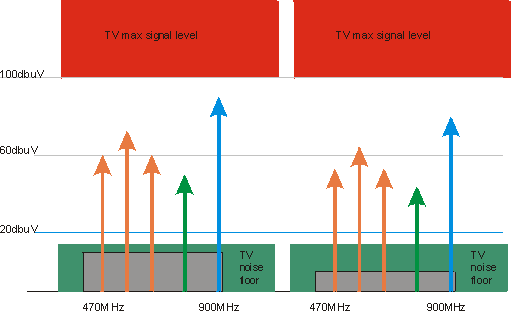
Fig.4 - what the TV gets before the loss (left) and after (right)
We have a signal from the aerial (left image) which has the following signal levels. Everything is within spec[5] - though only just for the two weakest analogues.
| Channel | Type | level (dBuV,75R) |
| 26 | Analogue | 60 |
| 33 | Analogue | 70 |
| 45 | Analogue | 60 |
| 56 | DTT[1] | 50 |
| 900MHz | Mobile phone | 90 |
| all | noise floor[3] (in 8MHz BW) |
10 |
On the right is the same aerial signal, but this time with a 10dB loss in the downlead. That, I remind you, is 50m of CT100 cable - that is one heck of a lot of cable. If you have a pad that large, I would suggest you are rich enough to use a CAI contractor and stop mucking around trying to do this yourself. But if you have to...
You have a modern TV, which has a noise figure of 6dB rather than the piece of junk below. You have a noise floor of 16dBuV so you can manage the minimum PAL spec[5] (43dB C/N) from the minimum signal level of 60dBuV. Great. You now put in 10dB of loss in the downlead.
You can immediately see that you've lost carrier to noise. Less of each arrow is clear of the TV noise floor. 10dB less in fact. Your weak analogues are now coming in a 50dBuV, which combined with a noise floor of 16dB give you a 34dB C/N - out of spec (min 43dB).
Passive attenuation like cable after the aerial before your first amplifier always costs you the value of the attenuation's loss of carrier to noise at UHF TV frequencies unless you are in an incredibly electrically noisy environment which don't occur in domestic situations.
Let's bring along a booster amp. I couldn't find the specs for the sort of thing they sell in B&Q to plug in at the back of your TV set, so let's use one I can find specs for - a Maxview SSB1CRG.
| Maxview SSB1CRG | |
|---|---|
| Bandwidth (MHz) | 40-860 |
| Noise Figure | 3dB |
| Gain | 14dB |
| Max O/P (2ch) -46dB Cross Mod |
110dBuV |
| Max O/P (5ch) -46dB Cross Mod |
104dBuV |
A perfectly respectable performance, and a good match for this situation. The noise floor for this is about 13dBuV[2] referred to the input.
There are two places you can stick your amplifier. There's the right place - in the loft, just after the aerial comes in. And there's the wrong place, next to your TV set. Some people call these setback amplifiers!!!
Put the amp in the right place, at the top.
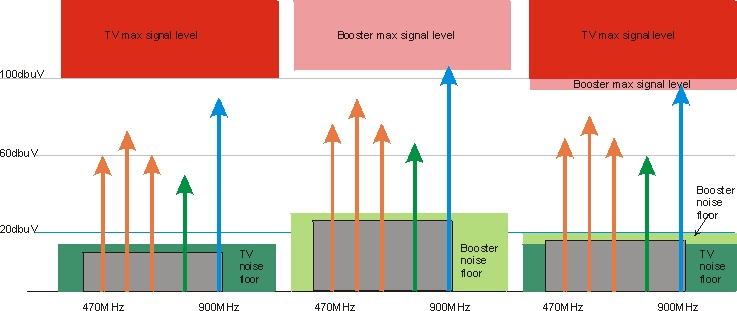
The overall noise figure is pretty similar - you gain a little carrier to noise ratio since the amplifier had a 3dB noise figure rather than your TVs 6dB, so you have a 47dB carrier to noise on you 64dBuV analogue channels at the receiver. The TV will lose some of that as its noise floor is only just below the signal noise floor, but you aren't any worse off noise-wise that you were if the TV were located in the loft, and it's a lot easier for the family to watch now it is in the living room. Note that you have lost the capability to handle large interfering signals - that moble phone interference could get 10dB higher before it went over the top before, whereas now it is right on the limit of the booster amplifier's handling capacity.
You can't blame Joe Public too much - some manufacturers actually call these damn things set-back amplifiers. Plus you don't need to provide power in the loft - heck, whack in your amplifier just behind the telly.
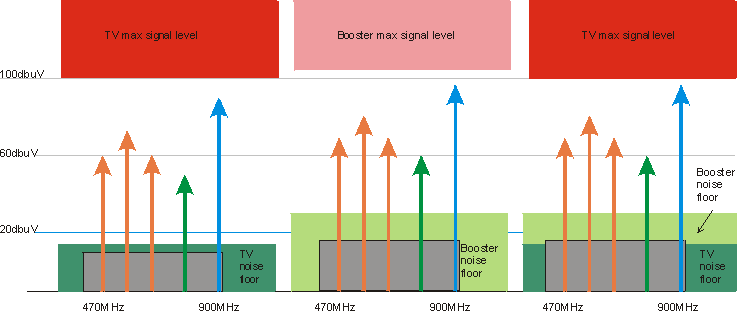
First the good news. You got more overload capability - about 6dB instead of zilch.
Now the bad news - you've lost 10dB carrier to noise, so you'll lose about 10dB signal to noise on analogue. It doesn't cost you any less to do it wrong than to do it right. So do it right.

here is results of an experiment feeding a 59dbuV signal through a 20dB loss and a 22dB amplifier. On the left the amp was before the loss. On the right the loss was before the amp. Increased grain is noticeable on the right, and looks less bad on stills than the shimmering on the moving image. Put your amplifier before the loss.
Sometimes you just need to feed one aerial into two sets. Obviously just dividing the signal gives you half as much each way (with a passive splitter please, none of this wiring the aerial feeds into a terminal block - you need to preserve matching!)
Loss is loss, whether you pick it up in the downlead or by splitting the signal. So you get a nice range on boosters called distribution amplifiers which consist of an amplifier followed by a splitter of 2,4 or more ways. The gain of the amplifier is usually matched to the splitter so the input to output level is very similar.
These are okay to put behind your TV. The reason this is OK is that the amplifier comes before the loss - it's all in the same box!
The reason I say above it should be in the loft is that is normally the best place to feed a bedroom TV and the main TV with the shortest downlead to each, and distribution amps often have a little bit of input to output gain which neatly compensates for about 10m of CT100. This loss is low, so don't sweat it.
Let us look at the original correct usage for a booster amplifier. This doesn't really apply to modern sets, with the exception of some PC card TV tuners, so you may prefer to concentrate on the modern application of compensating for loss.
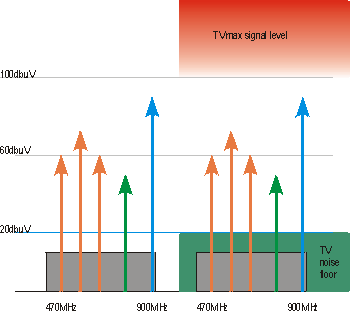
Fig 1 - signal at aerial (left) into a poor quality TV
On the right I have shown this going into a television set. It's a fairly bad television set, in that its noise floor is 20dBuV so it cannot achieve a 43dB carrier to noise ratio at the minimum analogue level spec of 60dBuV. If you pick an old black-and-white 26" set out of a skip you might get one that bad, but you haven't been able to buy one that poor for about 15 years. Note it also has a maximum input level, 100dBuV in this case.
This was the original situation boosters were designed for - noisy old valve front-ends.
Let's see what we get at the output of tie Maxview booster amp referred above.
| Channel | Type | level (dBuV,75R) |
| 26 | Analogue | 74 |
| 33 | Analogue | 84 |
| 45 | Analogue | 74 |
| 56 | DTT[1] | 64 |
| 900MHz | Mobile phone | 104 |
| all | noise floor (in 8MHz BW) | 27 |
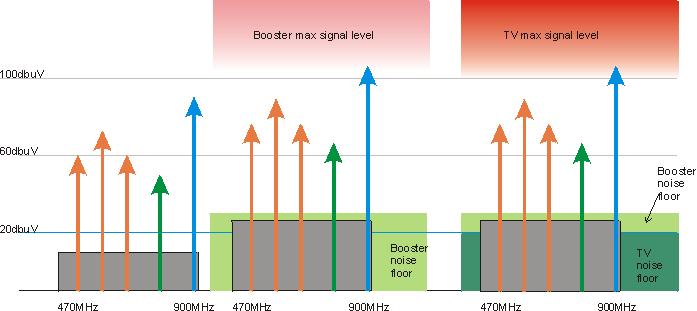
Fig.2 - improvement using a booster.
left - at the aerial out, middle - booster output, right - as the TV sees it
when you compare what the TV sees with the original situation you will see that there is much more of the signal arrows uncluttered by noise. The analogue carrier to noise ratio is 47dB with the amplifier and 40 without for the weaker of the two analogue channels. The minimum Carrier to noise spec[5] for UK UHF analogue TV is 43dB so this has brought an out-of spec system within spec. Congratulations and pats on the back all round.
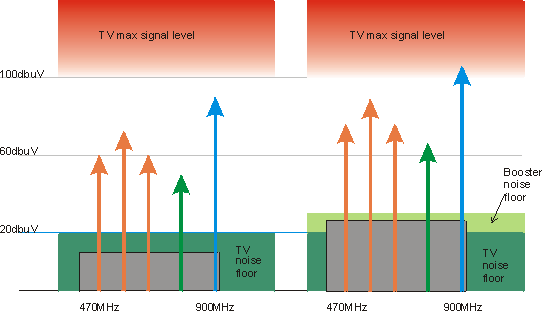
Fig.3 before and after comparison.
left - without boster, right, with booster
Now look at the mobile phone interference. It's coming in at 4dB over the maximum spec of the TV. Hopefully the TV filters enough of that out to bring it below 100dBuV, because otherwise you will now see horizontal line flickering on the screen when the phone contacts the base station. Not so bad on analogue, but on DTT you would get picture freezes. This is why boosters generally make you more sensitive to impulse interference.
I hope there aren't m any TVs like this still in service. On a modern TV the noise floor is about the same as the booster, so you gain no advantage from the booster, but it makes you more sensitive to impulse interference. So don't use them for this purpose. Unless you are using them before a known loss to correct for the loss.
Now you know how they should be used, and how few opportunities arise in the domestic environment to use them correctly, maybe you read about the misconceptions that make boosters commonly misused.
Selecting and siting your TV aerial
real aerial measurement of DTT performance with decreasing signal levels + adding booster
Why DTT is different from an analogue install